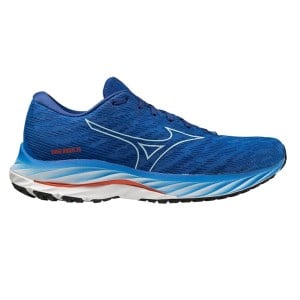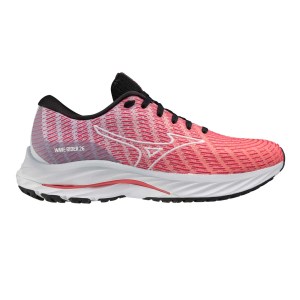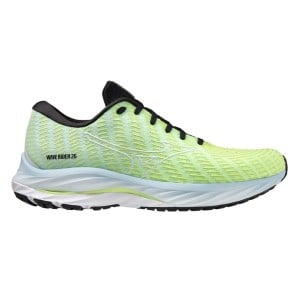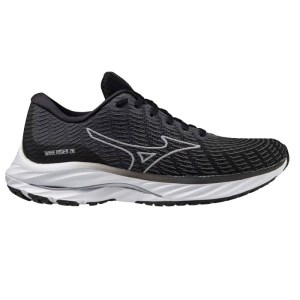Mizuno Wave Rider 26 vs 25 Comparison Running Shoe Review
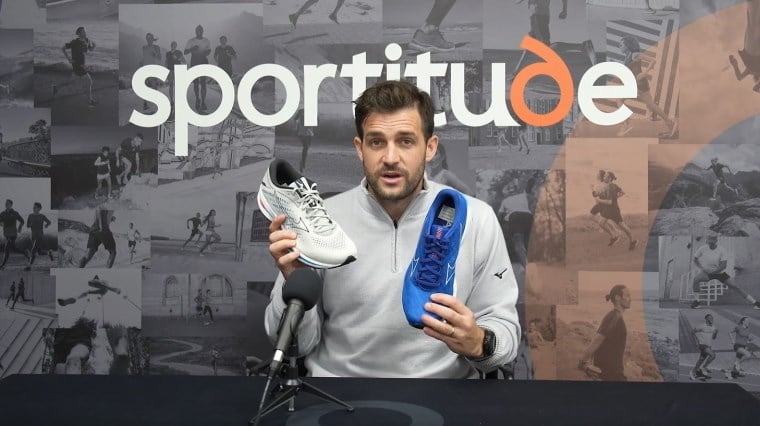
The main difference between the Mizuno Wave Rider 26 and the Mizuno Wave Rider 25 is that the Mizuno Wave Rider 26 is fractionally heavier with a higher stack height, increased cushioning, stability and outsole coverage. A little extra weight is a worthy trade-off for improved performance and comfort, continuing its role as Mizuno's most popular running shoe globally. Loyal Mizuno Wave Rider runners will love this ever-reliable ride.
The Mizuno Wave Rider 26 is a stable neutral mileage shoe with protection and durability to go the distance. Your feet are rewarded with out-of-the-box comfort with a durable Jacquard mesh upper that surpasses the breathability of its predecessor, a soft lining and gusseted tongue to stabilise the fit. The heel counter stays true to the Mizuno Wave Rider 25 – creating a secure and comfortable lockdown.
The midsole offers a sweet spot of cushioning – not too spongy, not too firm - with Mizuno Enerzy foam in play. The Wave Plate is an essential piece of technology to keep Mizuno running shoes standing out from their competitors. It's strategically positioned to provide structure and integrity on footstrike to keep your feet secure on the platform.
The Mizuno Wave Rider 26 caters to heel strikers with high-stress zones of the outsole reinforced with hard-wearing rubber to extend the lifespan of your go-to mileage running shoes.
Check out the review with full transcript below.
Hi guys, welcome to Sportitude Running. My name is Josh and it's shoe review time today. We're going to be talking all things Mizuno Wave Rider 26. Like all of my long comparative reviews, we’ll look at the Mizuno Wave Rider 25 and compare it to the Mizuno Wave Rider 26. We’ll give you all the information at home about the changes in the outsole, midsole and upper to potentially make this your next shoe purchase. Without further ado let's get stuck in.
Runner Profile
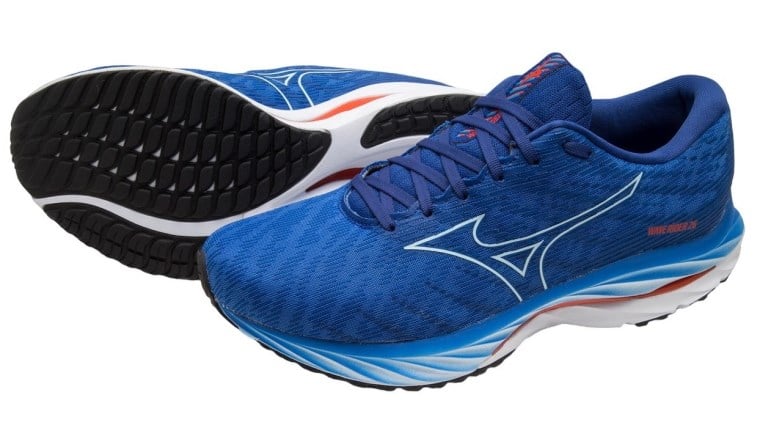
Before we jump into the engineering features of the Mizuno Wave Rider 26, let's talk about the foot type and who this shoe is designed for. It is a neutral shoe which means on the medial side there's no additional arch support system, dynamic or guidance control. It is designed for someone who comes down, be it heel or midfoot first. As you come through to midstance there's not a lot of favouritism towards that medial side.
Someone who's relatively neutral to mildly supinated could sit themselves in the Mizuno Wave Rider 26 and be quite happy. We have done a foot type review or foot type comparison in our video and blog on What Type Of Running Shoes Is Best For Me?
Being a cushioned shoe, the Mizuno Wave Rider 25 is going to cater quite well for those runners searching for some protection underneath their foot out on the road.
It is a mileage shoe. It's not the most cushioned neutral shoe from Mizuno. They have the Mizuno Wave Sky 6 which is available now. That running shoe is marginally heavier but with that you get the extra cushioning underneath your foot.
The Mizuno Wave Rider 26 is a little bit lighter but still offers plenty of protection underneath the foot. It can be relatively versatile as well. You can use it for your long runs but also can double down for a session or two here or there.
Now for the fun part, let's get talking all things Mizuno Wave Rider 26 starting from the ground and we'll work our way up.
Outsole
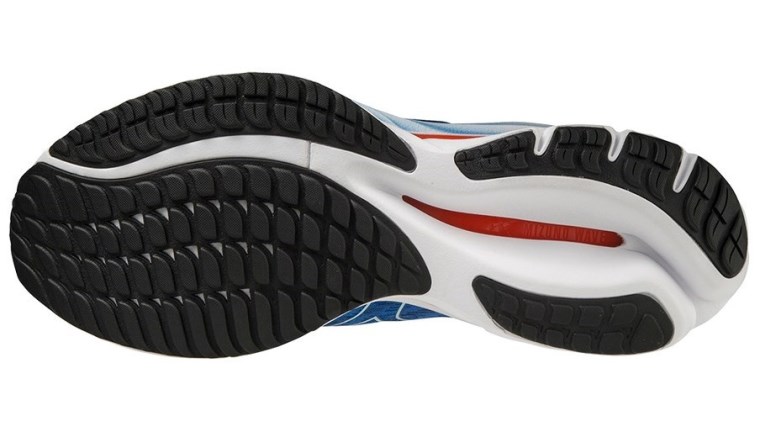
First things first, let's have a look at the outsole of the Mizuno Wave Rider 26.
There is a lot of change to be honest regarding the Mizuno Wave Rider 25 to the Mizuno Wave Rider 26. Through the heel of this shoe there's not a lot of change but they still have that vertical decoupled cut-out through the back half of the heel unit.
You have the Crash Pad which is catering for that entry point for heel strikers. As it comes up to your midfoot strike zone, there’s a little bit of rubber on offer which is great. It’s not too dissimilar to what we had last year with the Mizuno Wave Rider 25.
It offers plenty of coverage in the back half for the entry point. It has harder wearing rubber at the higher friction point for your heel strikers. At the midfoot region there's the U4ic cushioning system underneath the foot.
However, regarding the Mizuno Wave Rider 26 the biggest change is through the forefoot. Holding it up side by side with the Mizuno Wave Rider 25, you can see that there's a lot more coverage on offer through the Mizuno Wave Rider 26 regarding the amount of rubber on play.
When Mizuno released prototype one of this shoe, the outsole was and is pretty similar to the Mizuno Wave 25. What they found was because they altered their cushioning system and stack height ever so slightly with the Mizuno Wave 26, they weren't getting that forefoot performance which they were searching for. They had to revert back to the drawing board and create a little bit more of a stable platform.
That's why you can see this little vertical line on the outsole which continues up on that lateral side. It's going to provide a lot more support and stability under that first and second metatarsal region of your forefoot on that medial side. It’ll give you a bit more stability, increasing the overall surface area of this outsole through the front half.
Having a little bit more shoe and more real estate just gives you a better, more consistent platform as you release out of your gait cycle.
Upper
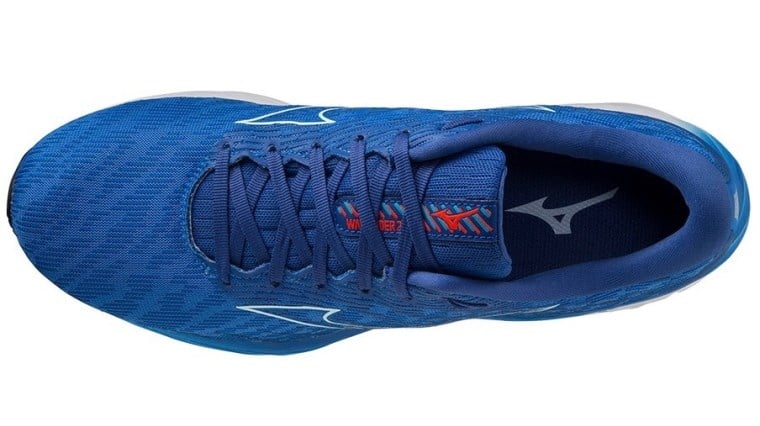
Jumping to the upper of this shoe first, let's discuss what Mizuno have done regarding executing their upper. First things first, when we look at the shoes back to back, side by side, the heel counters are almost identical. Mizuno have been known for a number of years now to have really good, solid heel counters and nothing has changed in the Mizuno Wave Rider 26.
They have that plastic construction in the back, that internal heel counter which gives your heel and your calcaneus a really good stable lockdown and which ensures you don't get too much movement on that entry. When you're a heel striker, the last thing you want your foot to do is move around before you get yourself rolling through to your midstance phase.
The internal heel counter is fantastic. It’s nice and solid with the appropriate amount of memory foam on the inside and you'd expect that. With a plastic device you want a bit of foam to give you some comfort and protection. They've used a really soft lining so in terms of the overall first fit and feel it’s fantastic.
As we come through to the midsection of this shoe, what you find with Mizuno is they use that gusseted tongue construction. What that means is you have the gusseted strap which sits on the tongue. It comes down to the midsole on the lateral and the medial side to help the overall fit and feel on top of your arch. It conforms to create a stabilised factor out of your gait cycle.
When you're coming through your midstance phase, you don't want to be moving around that platform. You're nice and stable with the heel counter but then we don't want to lose control as we come through the midstance. That gusseted tongue helps lock that foot down which is absolutely perfect.
Coming through to the forefoot, we have Jacquard mesh on offer in comparison to last year where we had engineered mesh. The difference between the two is the Jacquard mesh is a little bit stronger and in my opinion the Mizuno Wave Rider 26 breathes a little bit better than what it did last year.
It's important because when you're looking at mileage shoes, you're going to be out the road for a considerable amount of time. It could be 20 minutes for some or it could be an hour or an hour and 20 minutes for others, or it could be more. You want to make sure this running shoe is going to give you ample amount of breathability and that's exactly what this upper provides in the Mizuno Wave Rider 26.
The Jacquard construction has a good strong configured fit with plenty of ventilation through that forefoot from a fit perspective. I just have to call it out - I feel that the Mizuno Wave Rider 26 is marginally deeper through the toe box.
What I'm talking about there is how much space or wriggle room you have, that’s probably the best terminology to use. I get a little bit more wriggle room in the Mizuno Wave Rider 26 than I do in the Mizuno Wave Rider 25, and that's due to the fact it has a little bit more volume through the front half the shoe.
It does come in two widths. I want to call that out as well. In the men's model we have a D width which is standard and a 2E width which is a little bit broader. In the women’s model we have a B width which is standard and a D width which is a little bit broader. When brands make their good shoes in widths it’s fantastic.
Midsole
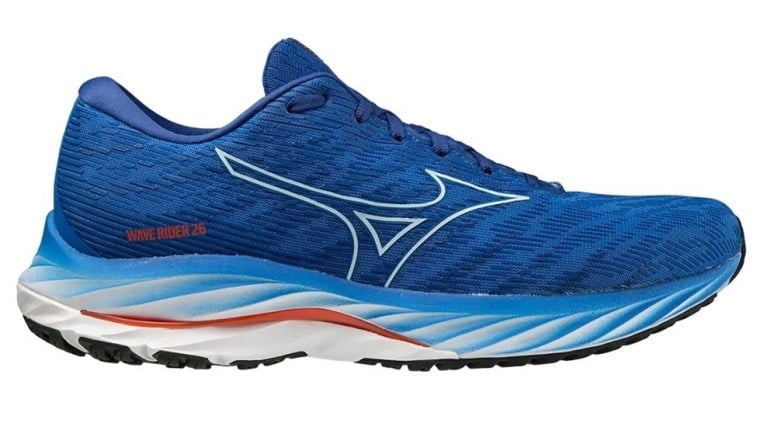
Let’s jump to the performance factor of this shoe. We're going to talk all things midsole. First things first, Mizuno have addressed a bit of mild criticism across the industry that their shoes are a little bit firmer than what they are in comparison to competitors.
That's not such a bad thing. There are a lot of runners out there that prefer that slightly more responsive feel underneath the foot. However, if Mizuno didn't change they were probably going to fall a little bit behind. They had to address the overall performance of this midsole with Mizuno Enerzy.
Mizuno Enerzy is the foam which sits on top, and underneath the Wave Plate we have your U4ic cushioning system. Mizuno have told us that the Mizuno Enerzy foam this season in comparison to the last season is 17% lighter. Don't ask me how they've measured that, but we're going to trust Mizuno and back what they've done.
By making it more cushioned, they've popped it up a little bit in terms of overall stack height. Last year the stack height figures were a 36mm heel and 24mm forefoot. This year we we've gone 38.5mm in the heel to 26.5mm in the forefoot. It’s a 2.5mm change in overall stack. It's not astronomical but it does make a little bit of a difference. In that first step you can certainly notice a little bit more cushioning which I like.
The other consistent thing with Mizuno is they've kept that heel-to-toe drop the same. By keeping it a 12mm heel-to-toe drop in both the Mizuno Wave Rider 26 and the Mizuno Wave Rider 25, it's been the case now for a decade plus. They've really stuck to their guns regarding the heel-to-toe offset in this shoe.
We're seeing a lot of other brands like going from 12mm to 10mm to 8mm, and 8mm to 10mm to 12mm. There's a lot of variance in that 4mm range regarding the heel-to-toe drop but Mizuno believe that this shoe performs at its best when it has that 12mm offset so kudos to Mizuno.
The other thing to talk about with Mizuno is it wouldn't be a Mizuno review if I did not address or discuss the Wave Plate. The Wave Plate is their intellectual property - it's their massive point of difference. The Wave Plate helps give the shoe structure and integrity on entry, so when you're making a shoe or foam a little bit softer, you need to make sure that that Wave Plate is going to give this shoe a more conformed fit to hold that stability of that midsole. It does that from your entry whether you're heel or midfoot striking. As you transition through to your midstance, this Wave Plate does restabilise that foam and keep your foot on top of the important parts of this midsole.
With the increased stack height, the angle of decline will be marginally more, although the heel-to-toe offset is the same. They've just transitioned their Wave Plate a little bit further forward. It won't alter how it feels on entry for heel striking, but it will give this shoe a little bit more stabilisation as you come through to your midstance phase.
If they happened to use the Wave Plate positioning of the Mizuno Wave Rider 25 in the Mizuno Wave Rider 26, this midsole would lose quite a lot and you would probably bottom out of the forefoot too quickly. It’s a really good piece of engineering work from Mizuno regarding that positioning of the Wave Plate.
Key Statistics – Widths, Stack Height & Weight
Covering some key statistics, we've already touched on the widths so just for a quick refresher, we have a D and 2E in the men’s model, so two widths on offer. In the women’s model we have a B and a D width.
I want to address the weights of this shoe first and foremost. We have seen a subtle increase in the weight with 285 grams in the men's size 9 in the Mizuno Wave Rider 26. Last year and we had 275 grams on offer in the Mizuno Wave Rider 25, so it’s a 10 gram bump. It's an absolutely fair trade-off because you get more cushioning, more stability and obviously a little bit more outsole coverage which should help the overall durability of this shoe. I'd happily trade 10 grams to get that performance factor.
Last year with the women’s Mizuno Wave Rider 25 we had 230 grams and we've gone up to 235 grams in the Mizuno Wave Rider 26, so that’s a 5 gram bump.
Just again, a little refresher to touch on, it has an increased stack height at 38.5mm in the heel and 26.5mm in the forefoot. Last year we had a 36mm heel and 24mm forefoot, so that 2.5mm jump in overall stack height that has obviously been included in that extra weight.
I think it's a good thing, putting performance first and the weight is a mild trade-off so well done to Mizuno.
Similar Shoes To The Mizuno Wave Rider 26
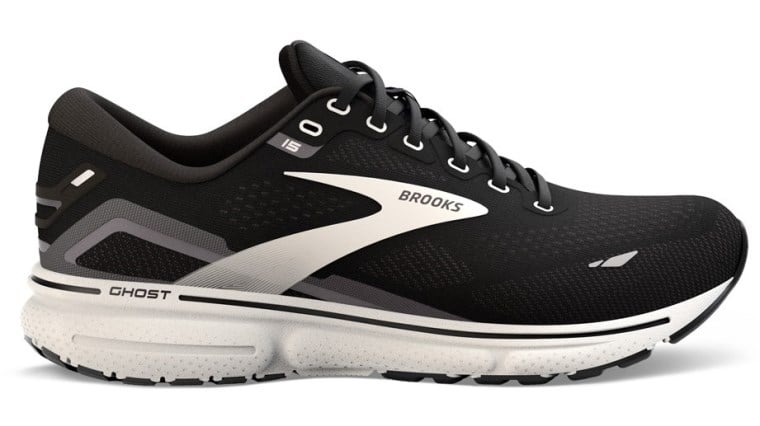
The Mizuno Wave Rider 26 sits in that stable neutral category, a category that is growing year on year. When we're talking about other competitors or other comparisons out there you have your Brooks Ghost (Brooks Ghost 15 image above), Asics Gel Cumulus and your Saucony Ride running shoes. It's a category that is extremely versatile and a lot of runners can pick up that category of shoe and get the amount of cushioning needed for your long runs. They can also double down for some quicker runs and tempo days.
I find that category for want of a better term is probably our most searched for or most sold category downstairs on the shop floor because it really does meet a lot of needs.
The Mizuno Wave Rider 26 for full transparency is Mizuno's number one shoe globally. It's extremely popular, no surprises there. It's cushioned, it's light and it does talk to a very broad demographic being in that stable neutral, slightly cushioned category.
It’s going to compare quite well against the others downstairs which is great and overall comfort is probably going to be a leading factor. I reckon they've absolutely addressed that with the improvement of their midsole.
The Wrap Up
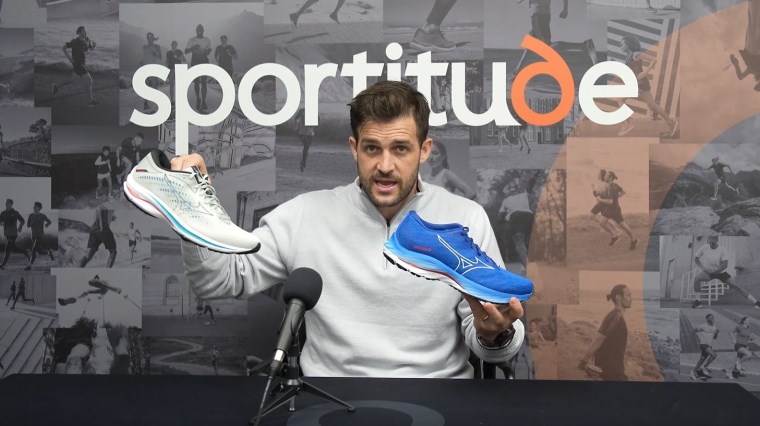
In summarising the Mizuno Wave Rider 26, in my opinion it’s an absolute tick. They've made some really big leaps regarding where they've come from with the Mizuno Wave Rider 25 and I say big with a pinch of salt because there's not a lot changes from Mizuno with regarding one shoe to the next.
Especially in their most popular shoe globally, you don't want to go back to the drawing board and re-engineer something wild and outrageous because you're going to lose a lot of those loyal Mizuno Wave Rider runners.
By just making those subtle changes including stack height, adding a little bit of weight, making the shoe softer and moving the positioning of the Wave Plate a little bit further forward, I really think they have checked all the boxes to make sure this shoe is going to pick up the Mizuno Wave Rider runners from the past.
Runners with experience in the Mizuno Wave Rider 24 and Mizuno Wave Rider 25 are going to be able to transition to the Mizuno Wave Rider 26 with absolute ease. The Mizuno Wave Rider 25 is probably going to take a little bit of market share away from some of those other competitors we discussed earlier.
This stable neutral category is extremely large to your global market share. That's why your Brooks Ghost, and Asics Gel Cumulus are very popular, and obviously that's why your Mizuno Wave Rider 26 is popular as well.
It’s important to note that when you come in and get yourself fitted to think about comfort first and the performance metrics will take care of themselves. I like what Mizuno have done with the Mizuno Wave Rider 26 and I think a lot of you out there will enjoy it as well.
If you've been a Mizuno Wave Rider runner in the past let us know your favourite one. I'd love to hear from all of you around the world about your running shoe selections. If you have used the Brooks Ghost or Asics Gel Cumulus please let us know what you think about those shoes.
If you have any additional questions, queries or theories about what we've discussed today with the Mizuno Wave Rider 26, please contact our Sportitude shoe experts.
Please subscribe to the Sportitude YouTube channel if you haven’t already done so and we'll keep knocking out these shoe reviews for you the running community all over the world.
Until next time, stay safe, keep chasing those PBs and we will see you on the road. Take care.
FEATURES
- Support: Neutral
- Upper: Mesh
- Midsole: Mizuno Enerzy
- Heel Height: 38.5mm
- Forefoot Height: 26.5mm
- Offset / Drop: 12mm
Men
- Weight: 285g / 10.05oz (US 9)
- Width: D (standard), 2E (wide)
Women
- Weight: 235g / 8.3oz (US 7)
- Width: B (standard), D (wide)
Mizuno Wave Rider 25
For a more in-depth shoe fitting experience, you can book a free 15 minute video chat in a Live Fit session or make an appointment to discover your RunDNA at Sportitude Running@Hindmarsh.
Happy running!
Follow Sportitude Running at:
Instagram: sportitude.running
If you liked this, then you'll love:
Running Shoe Guide 1: What To Do When Your Running Shoes Arrive
Running Shoe Guide 2: How To Break In Your New Running Shoes
Running Shoe Guide 3: How To Clean And Care For Your New Running Shoes

